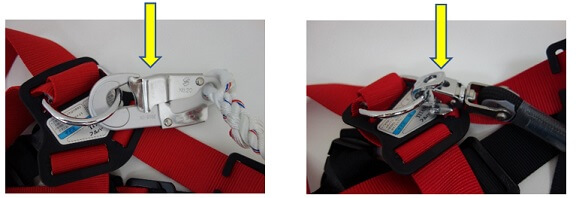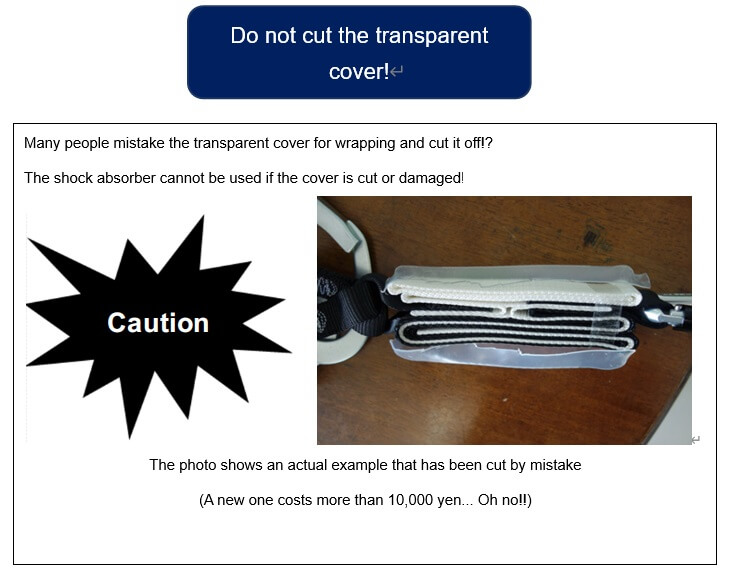[Chapter 2] Section 1 ②
2. Lanyard types and structures
The “lanyard” is the lifeline part of a safety belt. Parts such as a hook, D-ring, winder, shock absorber, and length adjuster are attached to a synthetic fiber rope or strap.

1. Lanyard types
There are three types of lanyards: rope, strap, and strap (belt rope) winding.
The rope type is a lanyard made of nylon rope with a diameter of 10-16 mm. Either three-strand rope or eight-strand rope is used for safety belts for general work at high places, and three-strand rope with a diameter of 16 mm is mainly used for safety belts for working on poles.

The strap type is a lanyard made of twill nylon strap, used instead of rope as a safety belt for general work at high places. replace it early.
Like an eight-strand rope, it has the advantage of being soft and easy to handle, but the strength declines more quickly than a three-strand rope, so it is essential to inspect the strap frequently and replace it early.
The strap (belt rope) winding type is a special-purpose strap for winding safety belts. This is a thin, narrow strap in which the high-strength aramid fiber of the core is covered with polyester fiber. The strap has high initial strength and is suitable for wind-up storage.
However, because the strength of the aramid fiber decreases at a rapid rate due to UV exposure and bending, care should be taken to watch for wear and tear on the strap surface. If such damage is observed, replace with a new winding type lanyard as soon as possible.

※Winding lanyards with a lock function are mainly recommended for use where the work place is at a relatively low height, because of the short fall distance compared to a regular lanyard.
2. Parts, etc. of lanyards
Connector
A device for connecting between a full harness or a body belt, and a lanyard, etc.

Hook
A type of connector and one of the components of a lanyard.
This is an annular device for connecting a lanyard to mounting equipment, or to a ring connected to a body belt or full harness.

※”Fall Arrest Equipment Standards” which came into force on February 1, 2019 define all “hooks, carabiners, and rings” as “connectors” in accordance with ISO standards. However, the conventional general names (hooks, rings, etc.) are used in this text for the purpose of explanation. (Same applies below.)
Winder
These devices wind up lanyard straps.
Some have a lock function to instantaneously stop unwinding the lanyard when a fall is arrested.
(Performance is affected by body weight of the worker, initial speed, and other fall conditions, so it’s not possible to determine the length of the strap that will be pulled out before it locks. Therefore, the total length of the lanyard must be used when calculating the falling distance.)

Shock absorber
This is a device for mitigating the shock produced when arresting a fall.
 Type 1 shock absorbers have an impact load of 4.0 kilonewtons or less when arresting a fall with a free fall distance of 1.8 meters, and Type 2 shock absorbers have an impact load of 6.0 kilonewtons or less when arresting a fall with a free fall distance of 4.0 meters.
Type 1 shock absorbers have an impact load of 4.0 kilonewtons or less when arresting a fall with a free fall distance of 1.8 meters, and Type 2 shock absorbers have an impact load of 6.0 kilonewtons or less when arresting a fall with a free fall distance of 4.0 meters.
(A newton is equivalent to about 0.102 kilogram-weight. Therefore, 4.0 kilonewtons yields an impact load 4000 times that, or about 408 kilograms. According to structural standards, both Type 1 and Type 2 must withstand the prescribed tensile load.)

A Type 2 shock absorber is on top and a Type 1 is on the bottom in both the left and right photos.
(Type 2 shock absorbers are usually larger.)

受講者様のご希望に合わせ、以下のタイプの講習会もご用意しています


このページをシェアする
講習会をお探しですか?